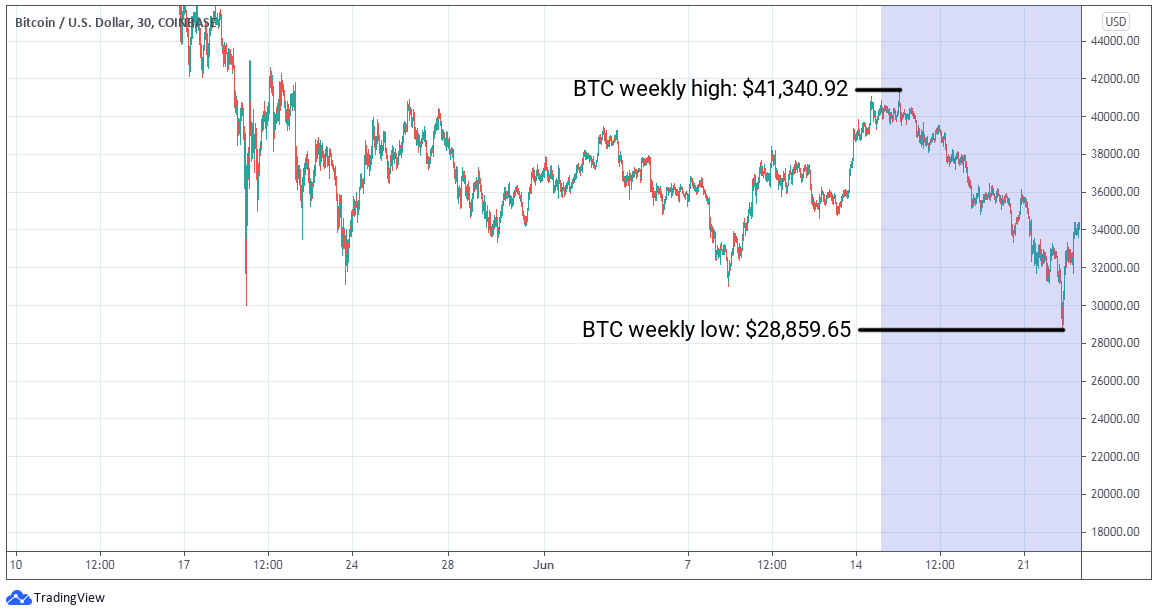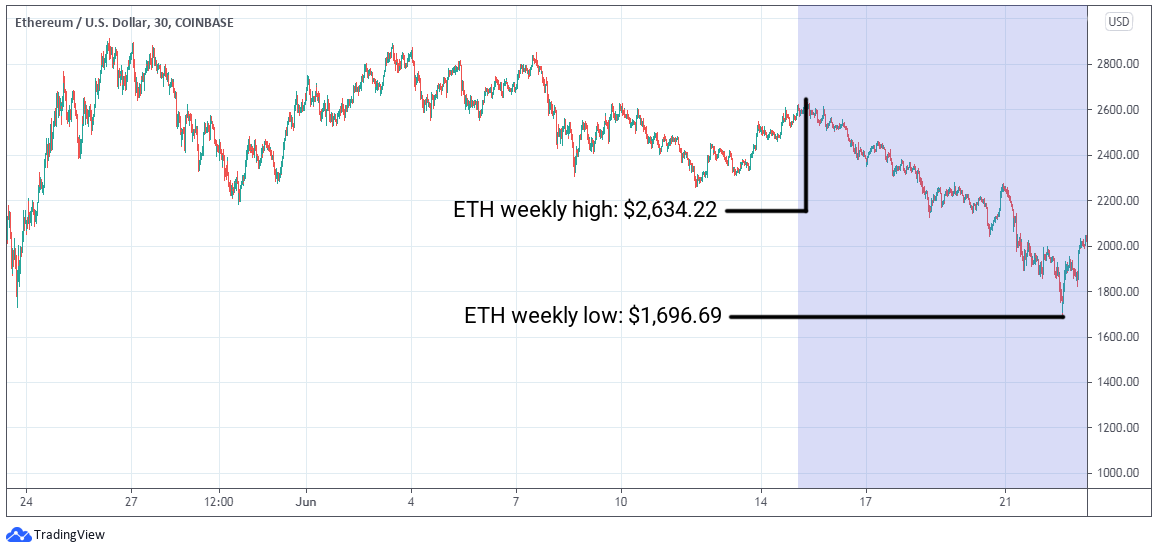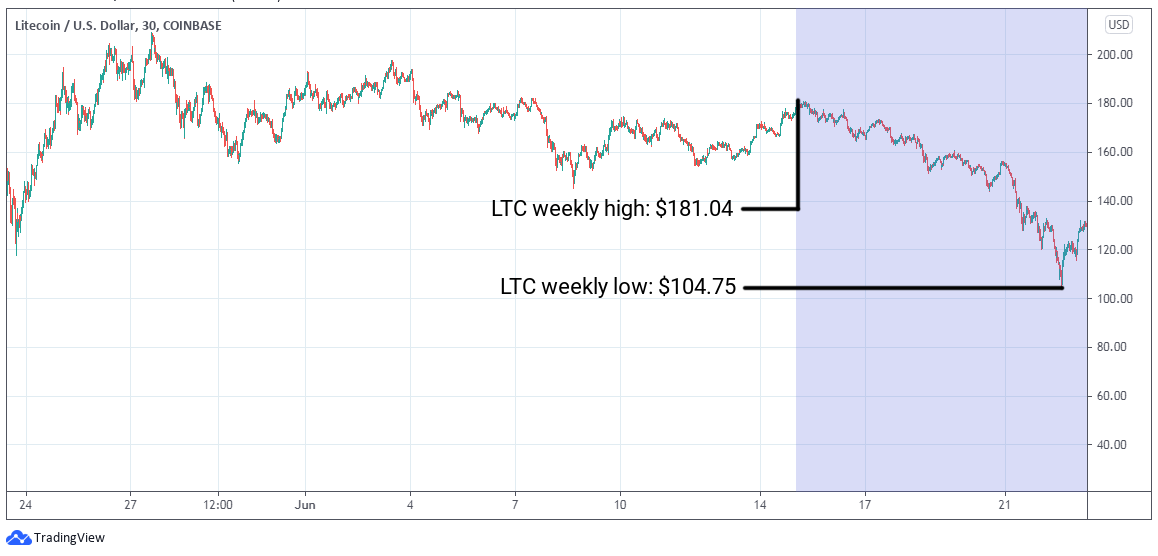- The de-Chinafication of Bitcoin: Cryptomining migration begins
China’s continuing crypto crackdown commanded most of the newsflow throughout the
week and dictated the markets. It’s the only story really worth considering in this week’s
Crypto Minutes, for its wide-reaching ramifications.
In May China’s political cabinet ignited a campaign to crack down on mining and
cryptocurrency trading, ostensibly to control risks to its population. The People’s Bank of
China, the country’s de-facto central bank, said this week it had called upon big banks and
payment processors, including Alibaba (NYSE:BABA) subsidiary Alipay, and
state-owned
lenders like the Agricultural Bank of China, the Postal Savings Bank of China and the
Industrial and Commercial Bank of China.
Speculative trading in virtual currencies roils economic and financial order, spawns the
risks
of criminal activities such as illegal asset transfers and money laundering, and endangers
people’s wealth.
People’s Bank of China, 21 June
China cannot control Bitcoin. And that is perhaps why the notoriously authoritarian state is
redoubling efforts to extricate itself from its crypto dominance. China has the perfect
surveillance technology coming in the form of the e-CNY, the country’s Central Bank Digital
Currency. All of its citizen’s purchases tracked, everywhere they go.
As of April 2020, an approximate 65% of Bitcoin hashrate — the computing power used to
generate new bitcoins, confirm transactions and secure the network — was concentrated in
China.
Those numbers are shifting daily as Bitcoin miners now flee China in ever increasing
numbers.
All signals seem to be indicating the greatest shakeup in the geographic makeup of bitcoin
mining since the start of the industrial mining era.
Nic Carter, CoinMetrics co-founder, 22 June
BIT Mining (NYSE:BTCM) has delivered its first batch of 320 mining machines to
Kazakhstan, Coindesk reports, with plans to move two more tranches totalling 2,600
machines by July. The company’s Sichuan operations were effectively shut down on 19 June
when it received notice that the state energy regulator would cut off its electricity supply.
Guangzhou’s Fengua International also told CNBC on 21 June it was airlifting 3,000kg of
mining machines to Maryland.
Authorities in the southwestern Chinese province ordered a halt to crypto mining, according
to a report from
the Communist Party-backed newspaper Global Times. More than 90% of
China’s bitcoin mining capacity is estimated to be shut down, the paper said.
One of the more interesting points to come out of this is how malleable the Bitcoin mining
network is. What other industry could simply break down its operations and move them
across the world in a matter of days?
Could Google’s parent company Alphabet (NASDAQ:GOOGL) pick up its server farms and
deposit them in a more energy efficient place overnight? Unlikely.
As CNBC reports , Texas could be one of the biggest winners from the great
cryptomining
migration.
Texas often has some of the world’s lowest energy prices, and its share of renewables is
growing over time, with 20% of its power coming from wind as of 2019. It has a deregulated
power grid that lets customers choose between power providers, and crucially, its political
leaders are very pro-crypto – dream conditions for a miner looking for a kind welcome and
cheap energy sources.
MacKenzie Sigalos, CNBC, 15 June
Bitcoin mining pools located outside of China — like Foundry USA — are expected to be
among the biggest winners of China’s policy shift.
So while in the near-term, crypto markets are taking this unprecedented uncertainty rather
badly, it does mean a reconfiguration of crypto power back into the hands of the West.
A more transparent future for Bitcoin and cryptoasset markets beckons. And the ability to
say definitively that cryptomining is being undertaken with more renewable energy? Surely
that will be a positive for those who can look beyond the immediate market drop.
Markets
BTC/USD
Throughout the week Bitcoin prices dropped back to where they were in late January, sliding
30.1% from a high above $41,000 under $29,000. By Tuesday, BTC was struggling to hold on
to $30,000 with a significant area of support in the $29,000 region. But as soon as pundits
were calling a bear market, Bitcoin rallied 18% back up into the $34,000 region, with
resilience the watchword of the week.
 Source TradingView
Source TradingView
ETH/USD
Ether too was roiled by retail uncertainty, with Ethereum’s base currency falling well below
the $2,000-mark it first captured in February 2021. The fundamentals of ETH continue to
impress, with DeFi total value locked still rising, but spot prices showed weakness
throughout out the week, shedding 35% from a high of $2,634.22 to to hit $1696.69, a two-
month low. By Wednesday morning it had rebounded 20.4% with lower values below
$2,000 clearly rejected.
 Source TradingView
Source TradingView
LTC/USD
The start of the week at $181.04 was the best it got for Litecoin, as the popular payments
protocol suffered a 42.1% capitulation from its peak to its zenith. Those intraday lows were
numbers not seen since the bull run of late December 2020, piquing interest in the potential
for a Litecoin bear market. There were brighter signs for LTC against the dollar, though, as it
bounced back 25.7% to end the week at $131.77.
 Source TradingView
Source TradingView
AVVISO IMPORTANTE:
Questo articolo non costituisce consulenza finanziaria, né rappresenta un'offerta o un invito all'acquisto di prodotti finanziari. Questo articolo è solo a scopo informativo generale, e non vi è alcuna assicurazione o garanzia esplicita o implicita sulla correttezza, accuratezza, completezza o correttezza di questo articolo o delle opinioni in esso contenute. Si consiglia di non fare affidamento sulla correttezza, accuratezza, completezza o correttezza di questo articolo o delle opinioni in esso contenute. Si prega di notare che questo articolo non costituisce né consulenza finanziaria né un'offerta o un invito all'acquisizione di prodotti finanziari o criptovalute.
PRIMA DI INVESTIRE IN CRYPTO ETP, GLI INVESTITORI POTENZIALI DOVREBBERO CONSIDERARE QUANTO SEGUE:
Gli investitori potenziali dovrebbero cercare consulenza indipendente e prendere in considerazione le informazioni rilevanti contenute nel prospetto base e nelle condizioni finali degli ETP, in particolare i fattori di rischio menzionati in essi. Il capitale investito è a rischio, e le perdite fino all'importo investito sono possibili. Il prodotto è soggetto a un rischio controparte intrinseco nei confronti dell'emittente degli ETP e può subire perdite fino a una perdita totale se l'emittente non adempie ai suoi obblighi contrattuali. La struttura legale degli ETP è equivalente a quella di un titolo di debito. Gli ETP sono trattati come altri strumenti finanziari.